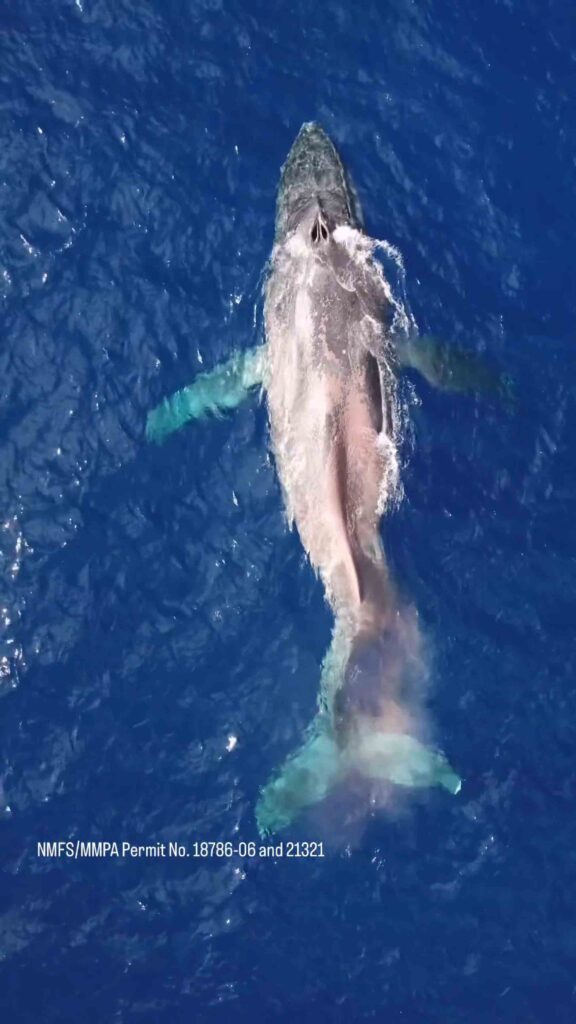Drone footage shows the incredible courage of a humpback whale as she struggles to complete a gruelling 3,000-mile journey with a broken spine.
The female whale – named Moon by marine researchers – had been spotted on the migration route from Canada to Hawaii.
Images show that the whale’s huge tale seems to be completely paralysed and curved in an unnatural shape.
Instead, she can be seen pulling herself along with just the power of her front, pectoral fins.
Experts believe she had probably collided with a large ship, damaging her spine.
Jens Currie, Chief Scientist at Pacific Whale Foundation which followed the migration to warmer waters, told Newsflash they captured the images of the coast of Maui when Moon arrived emaciated and covered in parasites.
He said: “The video was recorded on December 1st about half a mile off Olowalu, Maui. We were called to assess a report received of a sick or injured whale from a whale watching vessel in the area.
“I captured the drone video using a specialised drone equipped with lidar to record precise altitude, which allows us to measure the whale and determine the body condition and overall health of the animal.
“We can compare the body condition of Moon to that of non-injured humpback whales to determine the extent of impact the injury had on her health.
Jens also told Newsflash: “Moon was determined to likely be suffering from blunt force injuries caused by a probable vessel strike that occurred on her feeding grounds in British Columbia, Canada.
“The whale suffered from severe spinal trauma causing it to lose the ability to swim using its tail.”
It is sad news for staff at the Pacific Whale Foundation who have been following Moon’s movements since 2008 and picked up that she had become crippled on 7th September before confirming it with the footage in December.
The injury left Moon’s tale bent in an unnatural “S” shape, starting at her dorsal fin and running down to her fluke.

The organisation added in an online posting: “We were all devastated by the sight of this injury.
“She was probably also in a lot of pain and yet she still managed to migrate thousands of miles without having any use of her tail.”
Female humpback whales like Moon can weigh up to 35 tonnes and grow to almost 50 feet long, although it is unclear how large Moon is.
Every year she instinctively made the journey to warmer waters and in 2020, she was spotted with a calf but then was not seen directly until the Fin Island Research Station discovered her with the injury in September.
Pacific Whales wrote: “This is the stark reality of a vessel strike, and it speaks to the extended suffering that whales can endure afterwards.
“It also speaks to their instinct and culture: the lengths whales will go to follow patterns of behavior. Tenacity and tragedy.”
They concluded: ” Moon.. will not make it back. We will never truly understand the strength it took for Moon to take on what is regrettably her last journey, but it is on us to respect such tenacity within another species and recognize that vessel strikes lead to a devastating end.”
Jens added more details, confirming: “It is unlikely that Moon will be able to migrate back to her feeding grounds off British Columbia, as she is very emaciated (i.e. skinny) and in poor health.
“There is no food source readily available for filter feeding humpback whales like moon in Hawaiʻi.
“So, even if she could live with the injury, she likely does not have enough energy reserved (i.e. blubber/fat stores) to swim back to the feeding the grounds, which is a 3000-mile journey.”
The expert team had considered euthanasia but the amount that would be needed would also poison her body, making her potentially fatal for the animals that would then feast on her carcass.
Every year some 20,000 whales are believed to die from collisions with vessels.
Jens concluded: “It is remarkable that Moon was able to travel from British Columbia, Canada, to Hawaiʻi, USA without the use of her tail, using only her pectoral fins to swim.
“The poor condition of the animal when she was first sighted off the coast of Maui speaks to the toll that this took on her.”
To find out more about the author, editor or agency that supplied this story – please click below.
Story By: Michael Leidig, Sub-Editor: Marija Stojkoska, Agency: Newsflash
The Ananova page is created by and dedicated to professional, independent freelance journalists. It is a place for us to showcase our work. When our news is sold to our media partners, we will include the link here.




